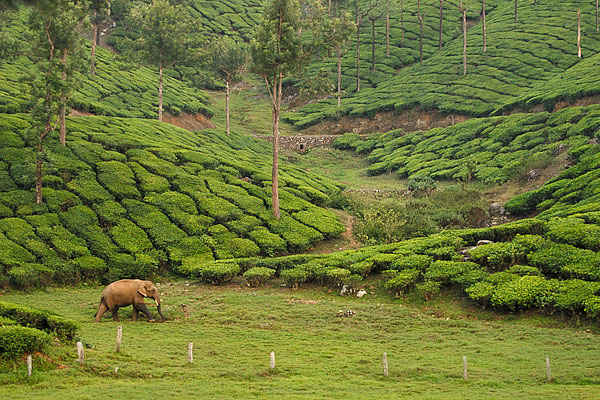Technology offers solutions for Human-Elephant Conflicts.
The dark hulks ambled in a single file across the stark green landscape of thigh-high tea bushes. Without a pause in their stride, the elephants made their way towards a tiny patch of forest. Save for the tree crickets, there were no other sounds. Had it been daytime, the elephants would have been harassed by people behaving like neurotic monkeys. On such occasions, despite their size, the elephants seemed so vulnerable, with nowhere to hide from their human hecklers.
About 150 years ago this was all prime elephant country; today it is a neatly manicured sea of tea punctuated by small fragments of forest. What could be of interest to the pachyderms here? Well, Valparai is surrounded by the forests of the Anamalai-Parambikulam Elephant Reserve and the animals routinely traverse the plateau as their great-grandmothers and fore-mothers did before them.
In 2002, when Ananda Kumar of the Nature Conservation Foundation (NCF) began work here, it was a public relations nightmare. People said there were “lots” of elephants causing problems “everywhere”. True, the animals didn’t eat tea but they demolished houses, broke into school kitchens, and punched gaping holes in the walls of ration shops to get at grain, lentils, sugar, salt and other choice objects of elephantine desire.
These were not the notorious bull-elephants that were butting heads with humans elsewhere. They were family herds of mothers, aunts, sisters, grandmothers and babies; they were supposed to be gentle, timid and cause no trouble. But in Valparai they were accused of killing an average of three people a year. People were angry, frustrated and terrified of the animals. As soon as the elephants entered their estates the tea companies chased them out again using tractors, jeeps and captive elephants. One estate would chase a herd onto the neighbouring plantation and a few hours later, the neighbour pushed it back. Sometimes this went on all day long. Despite their large size and fearsome reputation, the animals were being shunted around like pawns.
Frequently, the harassed elephants were stranded in the middle of tea plantations with no shelter or forage. When night fell, the starved and thirsty pachyderms fell on the nearest food source — shops, houses and kitchens. Then seven years ago the situation began to change.
Ananda began to pinpoint these incidents of damage on a map, identified individual elephants and tracked their travels until a pattern began to emerge. The elephants were not indiscriminately attacking all shops and houses. Three herds of about 40 animals regularly travelled along specific routes every season and this is where buildings were being damaged.
Once you know this, then the solution sounds easy: just move those shops and don’t stock food in the school kitchens. The number of incidents dropped by half! The other random incidents caused by chasing elephants also declined when two companies agreed to stop chasing them and instructed their staff to stay away from them.
Now, for the most problematic issue: human deaths. About 1,00,000 people live in widely scattered settlements on the Valparai plateau. The few people who were killed were walking without a torch after dark when elephants were about. They didn’t see the animals and blundered into them. Clearly the witless estate labour force did not have the savvy of the 6,000 tribal brethren living peacefully with elephants in the forests of the adjoining Indira Gandhi Wildlife Sanctuary.
Ananda began providing the location of elephant herds every day to Valparai Television Channel who broadcast it as a news ticker scrolling across the bottom of the screen. Now people had the information they needed to avoid accidentally running into the large pachyderms. During the 32-month experimental period, there was not a single human death caused by elephants. With fewer traumatic encounters, the animals were allowed peaceful right of way.
People with televisions have access to the information but what about people who don’t have one or those who arrive from other places? Such a situation occurred not so long ago. A man got off a bus at Iyerpadi at 11 pm. As he was walking down the slope, unbeknownst to him elephants were climbing up the same path. An alert watchman at a nearby factory flashed his torch in warning. The man retreated to the bus stop and stayed put until the elephants crossed. Had it not been for the watchman, he may have been severely injured or killed.
This incident provided the cue for the next phase of Ananda’s work. With funding from the Mohammed bin Zayed Species Conservation Fund, LED lights fixed on 10 foot poles are to be installed in 17 colonies and seven bus stops near areas frequented by elephants. Niagara Automation Company, who build the circuitry for mobile phone activated agricultural pumps, helped to devise a similar system for these beacons. Each is operated by five registered mobile phone users who will trigger it if elephants are in the vicinity, alerting all residents and new-arrivals to be cautious.
Once Ananda demonstrates that this innovative model is sustainable and replicable, it is hoped that the Tamil Nadu Forest Department’s Anamalai Foundation will take over the job of providing information on elephant movements.
Here’s how sustained effort and a touch of imagination can achieve major conservation success. It is also a prime example of how applying conservation in human landscapes can further the interests of wild animals.


 CI is a non-profit, non-commercial portal that aims to facilitate wildlife and nature conservation by providing reliable information and the tools needed to campaign effectively.
CI is a non-profit, non-commercial portal that aims to facilitate wildlife and nature conservation by providing reliable information and the tools needed to campaign effectively.